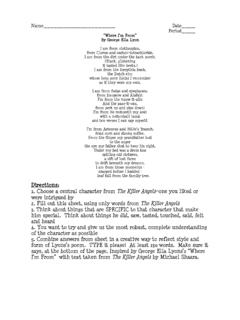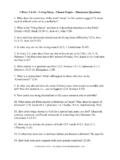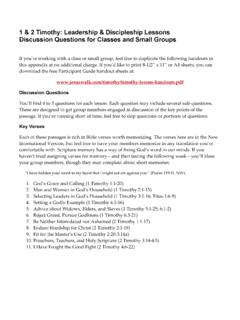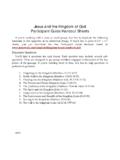Transcription of A Teacher’s Guide to - George Ella Lyon
1 A teacher s Guide to All the Water in the World Written by George Ella Lyon Illustrated by Katherine Tillotson discussion Questions 1. Before reading All the Water in the World, talk about the water you and your students use every day. What are sources of water in your home and at your school? How does water help you accomplish what you need to do every day? 2. Ask your students what feelings they have after reading or listening to All the Water in the World. What words, rhythms, and images create these feelings? How do they reflect our vital relationship with water? 3. Author George Ella Lyon says in the book, Water doesn t come. It goes. Around. What did you know about the water cycle, or the continuous movement of water in the world, before you read this story?
2 What did you learn about the water cycle after reading the book? Talk about how the words and illustrations in the book help you to better understand the Earth s water cycle. 4. Every living thing on the Earth needs water to thrive and survive. Name some living things found around your home or school that depend upon water. Do all use water the same way? 5. Ask your students how the weather affects the Earth s water supply in good and bad ways. Discuss the different climates in the world, and the importance of rain. If it s raining at your house, does that mean it s raining in every place all over the world? Why or why not? 6. Author Lyon writes with strong, dramatic words in this story, yet she also uses softer, more comforting language at times throughout the book.
3 While reading, ask your students to point out examples of both in the book. 7. Katherine Tillotson s beautiful illustrations show places that have a wealth of water, but also places where dry grasses rustle and dirt s just dust. Taking a close look at colors and movement, how do her illustrations differ for each place? How does she make water flow through the book? How does she stop and start it before and after the desert scenes? 8. One of the messages in All the Water in the World is that it s important to conserve, or save, water. What are some ways people waste water? How can you protect your water supply by making better decisions about your water use? 9. What if there was a drought where you live or the water was turned off for some other reason a chemical spill, for example what would you do?
4 How do we take water for granted? Do you think water will always be available? Why or why not? 10. What is your favorite activity involving water? Brainstorm the many ways you can play, create, and explore with water. Can you have fun with water only when the weather is warm? 11. The last page of All the Water in the World says keep Earth green! How does water keep the Earth green? What are some things you can do to keep the Earth green? Further Activities and Research 1. Identify sources of water in your town or school community. Do you live near the ocean, a lake, a river, a pond, or a stream? Find out what kinds of creatures, plants, and other living things depend on these water sources to live. 2. Be a meteorologist! Beginning on a Monday, have your students create a weather forecast for the week.
5 Kids can predict the weather by watching the local weather report on TV, listening to the radio, consulting a weather website, or looking in the newspaper. On Friday, take a look back at their forecast. Did it turn out to be accurate, or did the weather change throughout the course of the week? 3. Conduct some simple science experiments involving water in your classroom: a. Adopt a houseplant for your classroom. For one week, ask your students to water the plant on a regular basis, and then record how the plant responds. The next week, tell your students not to water the plant regularly, noting the results. What happens to the plant in both cases? b. Demonstrate the evaporation of water, part of the water cycle. Place a shallow dish of water on a bookcase or windowsill in your classroom.
6 Have your students observe what happens to the water after a period of time. Where does the water go? 4. Earth Day is celebrated on April 22 of every year. Find out why and when Earth Day began. Even though Earth Day is commemorated in April, how can you and your students celebrate Earth Day every single day of the year? 5. As a class, come up with some ideas on how to conserve water. Then have each student create a poster demonstrating these ideas. Hang the posters in the hallways of your school to encourage other students to conserve water as well. 6. All the Water in the World asks the question : Where does water come from? Do your students really know? Have each student find out more about their local water supplies. Ask them to find answers to the following questions: What is the source of their local water?
7 How does water travel from the source to their homes? How does water enter and exit their homes and your school? 7. Sing or listen to songs about water in your classroom. Choose some standards, such as Row, Row, Row Your Boat and Rain, Rain, Go Away, but also encourage your class to find some other water-themed songs, classic or current. 8. Taking a cue from author George Ella Lyon, ask your students to create a poem based on water. Then, have them illustrate their poems in the style of Katherine Tillotson. Try a group poem, gathering images from each student and making a mural with words and pictures. This Guide has been provided by Simon & Schuster for classroom, library, and reading group use. It may be reproduced in its entirety or excerpted for these purposes.
8








